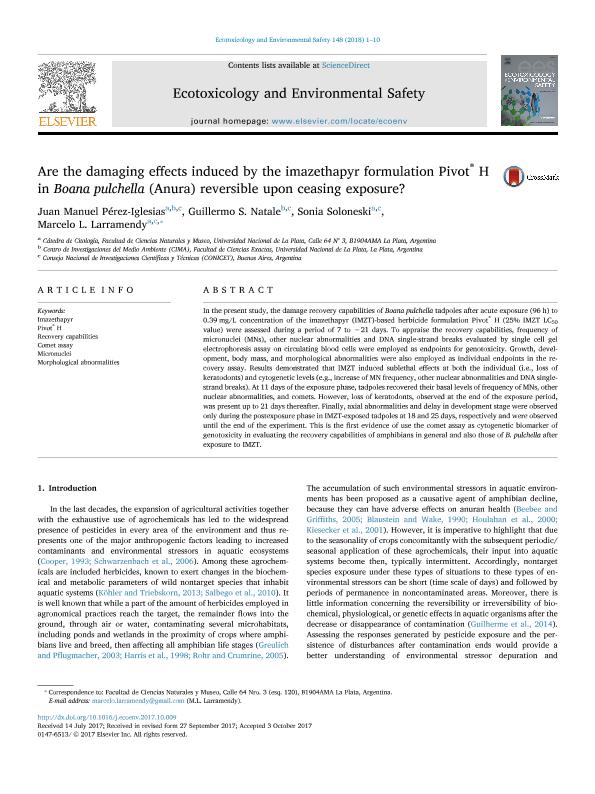Artículo
Are the damaging effects induced by the imazethapyr formulation Pivot® H in Boana pulchella (Anura) reversible upon ceasing exposure?
Pérez Iglesias, Juan Manuel ; Natale, Guillermo Sebastian
; Natale, Guillermo Sebastian ; Soloneski, Sonia Maria Elsa
; Soloneski, Sonia Maria Elsa ; Larramendy, Marcelo Luis
; Larramendy, Marcelo Luis
 ; Natale, Guillermo Sebastian
; Natale, Guillermo Sebastian ; Soloneski, Sonia Maria Elsa
; Soloneski, Sonia Maria Elsa ; Larramendy, Marcelo Luis
; Larramendy, Marcelo Luis
Fecha de publicación:
02/2018
Editorial:
Academic Press Inc Elsevier Science
Revista:
Ecotoxicology and Environmental Safety
ISSN:
0147-6513
Idioma:
Inglés
Tipo de recurso:
Artículo publicado
Clasificación temática:
Resumen
In the present study, the damage recovery capabilities of Boana pulchella tadpoles after acute exposure (96 h) to 0.39 mg/L concentration of the imazethapyr (IMZT)-based herbicide formulation Pivot H (25% IMZT LC50 value) were assessed during a period of 7 to −21 days. To appraise the recovery capabilities, frequency of micronuclei (MNs), other nuclear abnormalities and DNA single-strand breaks evaluated by single cell gel electrophoresis assay on circulating blood cells were employed as endpoints for genotoxicity. Growth, development, body mass, and morphological abnormalities were also employed as individual endpoints in the recovery assay. Results demonstrated that IMZT induced sublethal effects at both the individual (i.e., loss of keratodonts) and cytogenetic levels (e.g., increase of MN frequency, other nuclear abnormalities and DNA single-strand breaks). At 11 days of the exposure phase, tadpoles recovered their basal levels of frequency of MNs, other nuclear abnormalities, and comets. However, loss of keratodonts, observed at the end of the exposure period, was present up to 21 days thereafter. Finally, axial abnormalities and delay in development stage were observed only during the postexposure phase in IMZT-exposed tadpoles at 18 and 25 days, respectively and were observed until the end of the experiment. This is the first evidence of use the comet assay as cytogenetic biomarker of genotoxicity in evaluating the recovery capabilities of amphibians in general and also those of B. pulchella after exposure to IMZT.
Archivos asociados
Licencia
Identificadores
Colecciones
Articulos(CCT - LA PLATA)
Articulos de CTRO.CIENTIFICO TECNOL.CONICET - LA PLATA
Articulos de CTRO.CIENTIFICO TECNOL.CONICET - LA PLATA
Citación
Pérez Iglesias, Juan Manuel; Natale, Guillermo Sebastian; Soloneski, Sonia Maria Elsa; Larramendy, Marcelo Luis; Are the damaging effects induced by the imazethapyr formulation Pivot® H in Boana pulchella (Anura) reversible upon ceasing exposure?; Academic Press Inc Elsevier Science; Ecotoxicology and Environmental Safety; 148; 2-2018; 1-10
Compartir
Altmétricas



